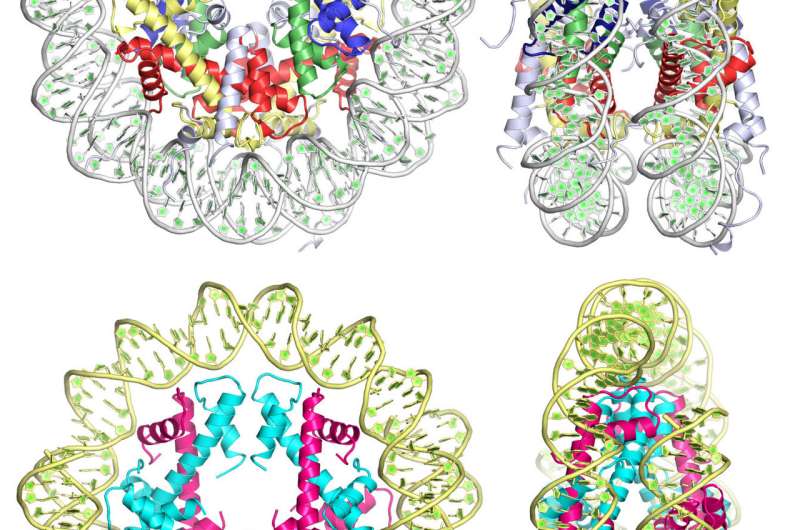Not so different after all: Human cells, hardy microbes share common ancestor

To Tom Santangelo, single-celled microorganisms called archaea are like ancient mariners, surviving among the most extreme conditions on Earth, including volcanic vents in the deep ocean.
The Colorado State University researcher studies how these hardy microbes – which constitute one of three surviving domains of life – express their genes, produce their energy, and thrive in hot, lightless environments.
It turns out, we're not so different – biochemically, anyway – from archaea after all.
Santangelo, associate professor in the Department of Biochemistry and Molecular Biology, was on a team that found striking parallels between how archaeal cells and more complex cells, including humans' and animals', package and store their genetic material. The breakthrough study, published in Science earlier this year, provided evidence that archaea and eukaryotic cells share a common mechanism to compact, organize and structure their genomes.
The study was led by Karolin Luger, now a structural biologist at the University of Colorado Boulder. Most of the results reported in Science were completed while Luger was a CSU faculty member, from 1999 to 2015.
DNA, histones, nucleosomes, chromatin
A little high school biology review: Eukaryotes are cells with a nucleus and membrane-bound organelles, and they include fungal, plant and animal – including human – cells. They're set apart from their less complex counterparts, prokaryotes, by the absence of a nucleus. While archaea and bacteria are both prokaryotes, they are only distantly related. Archaea are the likely progenitors of eukaryotes and share many of the same proteins that control gene expression.
One of life's most fundamental processes – the mechanics by which DNA bends, folds and crams itself into a cell nucleus – is common across all eukaryotes, from microscopic protists to plants to humans.
Packed inside the nucleus of every eukaryotic cell is several feet of genetic material that is compacted in a very specific way. Small sections of DNA are wrapped, like thread around a spool, roughly two times around eight small proteins called histones. This entire DNA-histone complex is called a nucleosome, and a string of compacted nucleosomes is called chromatin. In 1997, Luger and colleagues first reported the exact structure of eukaryotic nucleosomes via X-ray crystallography.
'Gnarly' crystallography
Science paper collaborator John Reeve had discovered in the 1990s that histone proteins were not limited to eukaryotes, but were also found in nucleus-free archaea cells. Reeves and Luger began a collaboration to crystallize histone-based archaeal chromatin and compare that structure with eukaryotic chromatin.
After years of stops and starts and trouble growing reliable archaeal histone crystals – Luger called it a "gnarly crystallographic problem" – the scientists succeeded in resolving the structure of archaeal chromatin, revealing its structural similarity to eukaryotes.
'Biologically meaningful' structure
In the data, the archaeal DNA seemed to form long, curvy, repeating superhelices. The researchers weren't sure if the structure was real, or an artifact of the experiment. That's where Santagelo's team at CSU provided key expertise.
"My group took up the challenge of determining whether the structure resolved in the crystals represented a biologically meaningful structure," he said.
Santangelo's team made variants of the archaeal histones and tested how the cells fared, as they disrupted the DNA superhelix. They found that the more they destabilized the structure, the sicker the cells got. Their efforts underscored the merits of the structure Luger's group had determined.
Being part of a team that provided so fundamental an insight as the ancestry of our cells was among the most rewarding moments of Santangelo's career.
"The major impact of the paper, I think, is that the idea of compacting DNA into those structures is a very ancient idea – probably more than 1 billion years old," Santangelo said. "Histone proteins came on the scene, and once they got into and started packaging genomes, they largely made themselves indispensable to those cells that encoded them."
Santangelo will continue conducting studies into the structure, function and energy transactions of archaea – those ancient mariners that now definitively represent an ancestral prototype of human cellular activity.
More information: Francesca Mattiroli et al, Structure of histone-based chromatin in Archaea, Science (2017). DOI: 10.1126/science.aaj1849
Journal information: Science
Provided by Colorado State University



















